CoP 29 EXPLAINED: WHAT’S AT STAKE FOR INDIA & THE WORLD?
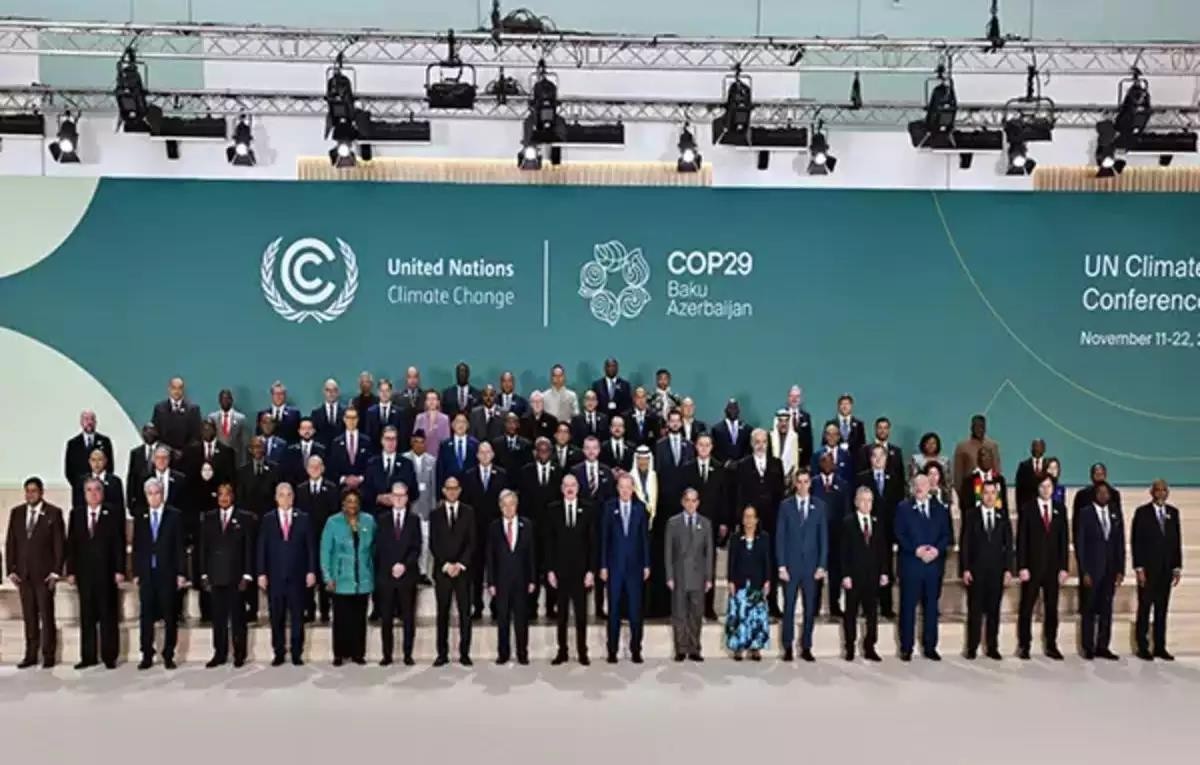
Context:
- India is likely to skip the February deadline for submitting the next round of climate action plans under the Paris Agreement requirements.
- These plans, called Nationally Determined Contributions or NDCs, are supposed to provide details of the climate actions countries intend to take up to the year 2035.
- India, and other developing countries, have expressed serious disappointment with the outcome of COP29, last year’s climate conference in Baku, which delivered an extremely weak agreement on climate finance.
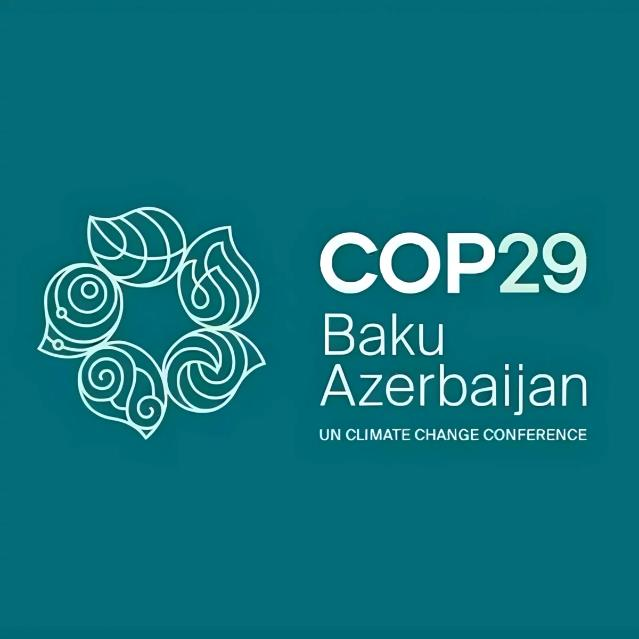
1.
What is COP?
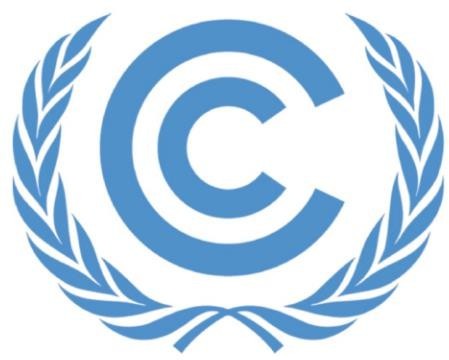
- COP, or the Conference of the Parties, is the supreme decisionmaking body of the United Nations Framework Convention on Climate Change (UNFCCC).
- It consists of representatives from all countries that are Parties to the Convention, which currently includes 197 nations.
- The COP's primary role is to review the implementation of the convention and its legal instruments, assess progress in achieving climate objectives and make necessary decisions to enhance effective implementation.
2.
What is the history of COP?
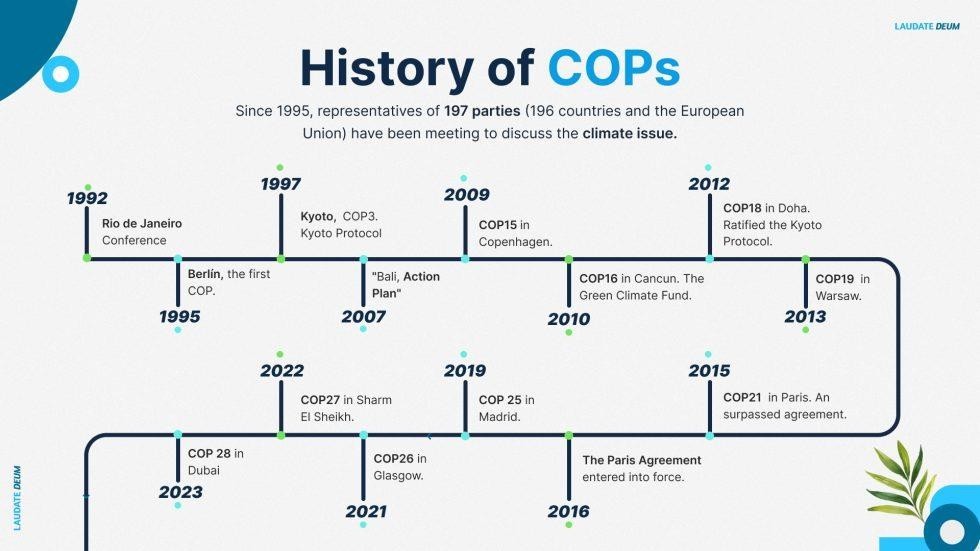
- In 1992, countries joined an international treaty, the United Nations Framework Convention on Climate Change, as a framework for international cooperation to combat climate change by limiting average global temperature increases and the resulting climate change, and coping with impacts that were, by then, inevitable.
- By 1995, countries launched negotiations to strengthen the global response to climate change, and, two years later, adopted the Kyoto Protocol.
- The Kyoto Protocol legally binds developed country Parties to emission reduction targets.
3.
What is the timeline of climate change conferences?
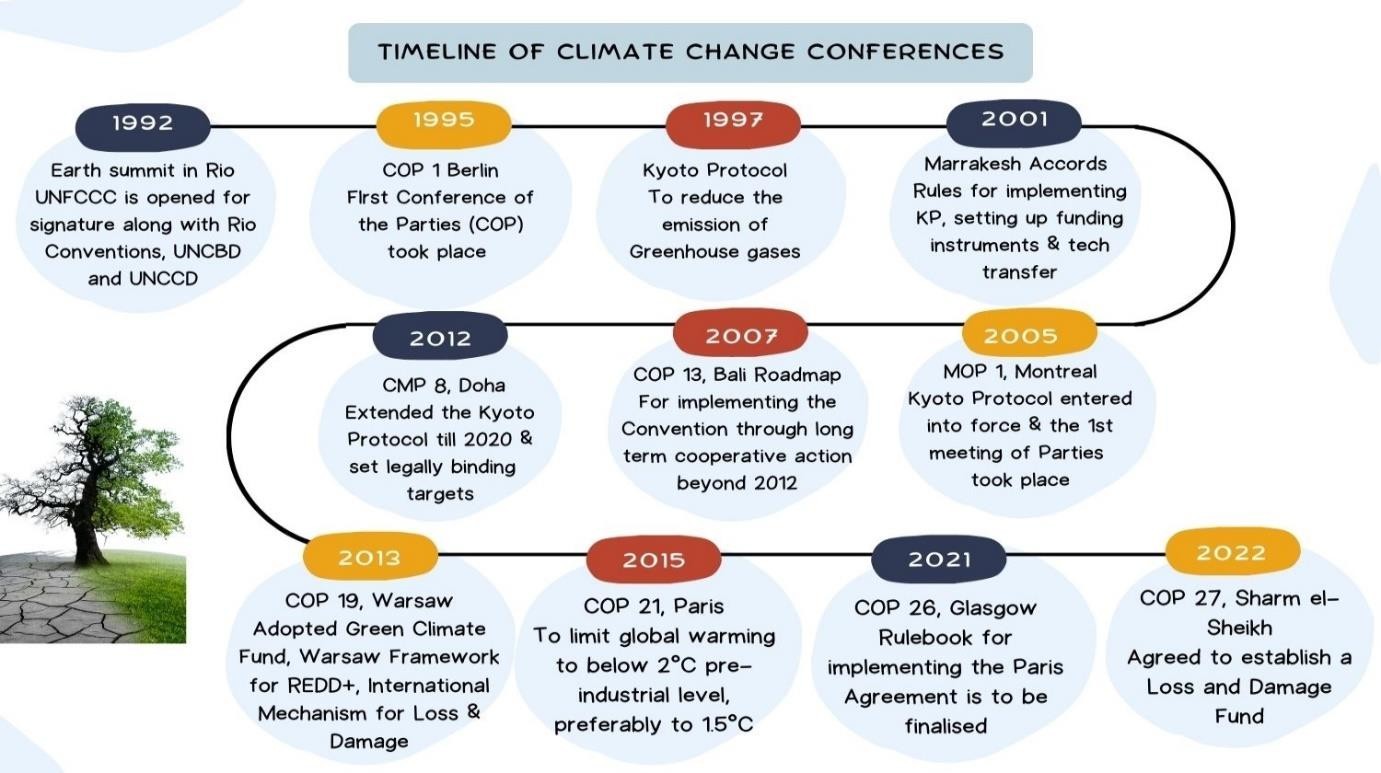
4.
What happens at a COP?
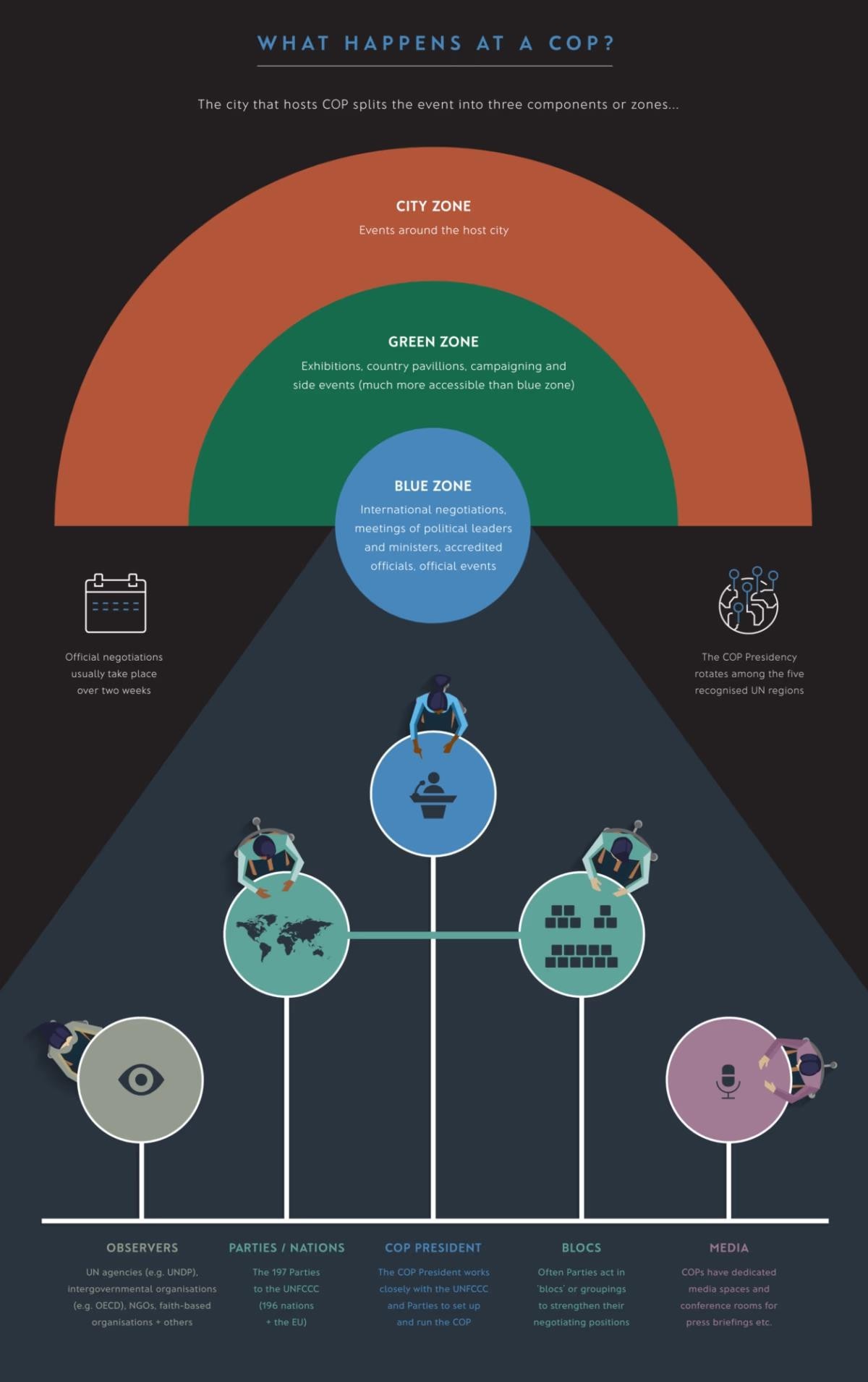
| Functions | Analysis |
|---|---|
| Negotiations |
|
| Adoption of Decisions |
|
| Reporting and Review |
|
| Reporting and Review |
|
| Side Events and Exhibitions |
|
| High-Level Segment |
|
| Stakeholder Engagement |
|
| Capacity Building and Technical Workshops |
|
5.
What are Green and Blue zones in COP?
- Each COP event is divided into two physical spaces or zones which house the activities of the conference:

| Zone | Description |
|---|---|
| Blue Zone |
|
| Green Zone |
|
6.
Enlist key milestones of COP?
| COP | Milestones |
|---|---|
| COP 3: 1997 |
 |
| COP 7:1997 |
Marrakesh Accords: 
|
| COP 12: 2006 |
Nairobi Work Programme:
|
| COP 13:2007 |
Bali Action Plan:
 |
| COP 16:2010 |
 |
| COP 21:2015 |
Paris Agreement:
 |
7.
What is COP 29?
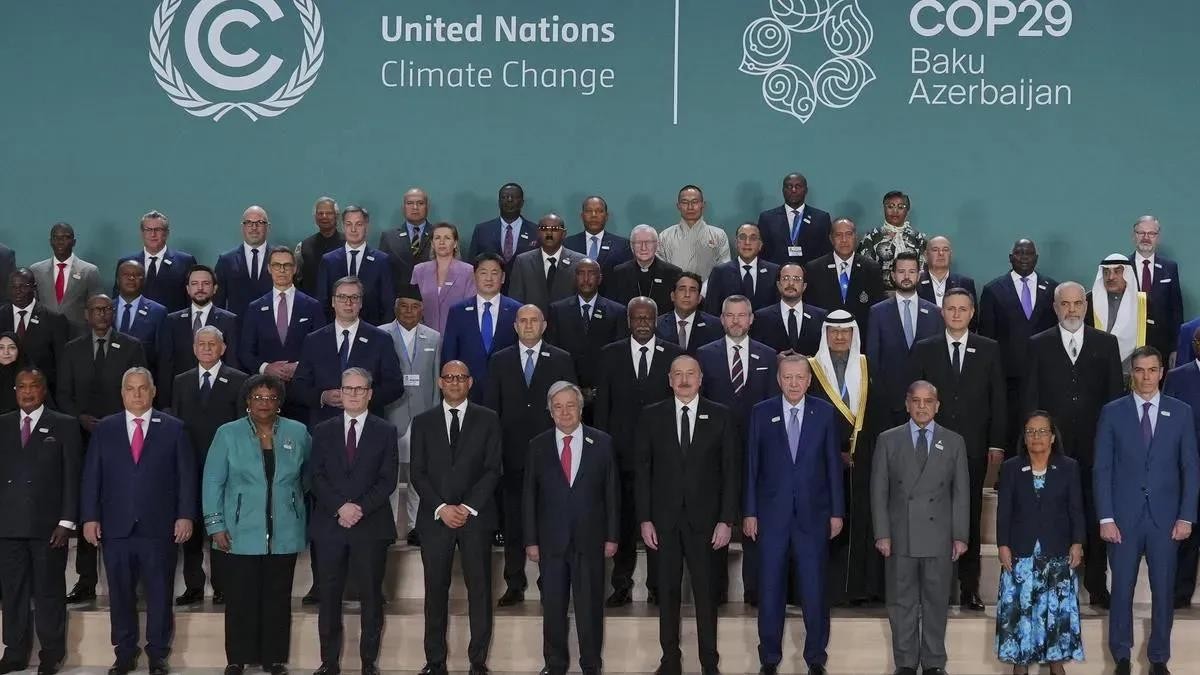
- The 2024 United Nations Climate Change Conference, also known as COP29,was held in Baku, Azerbaijan, from 11 to 22 November 2024, under the Presidency of Azerbaijan.
- The conference focused on climate finance and how to help countries protect their economies and people from climate disasters.
8.
Why does COP29 matter?
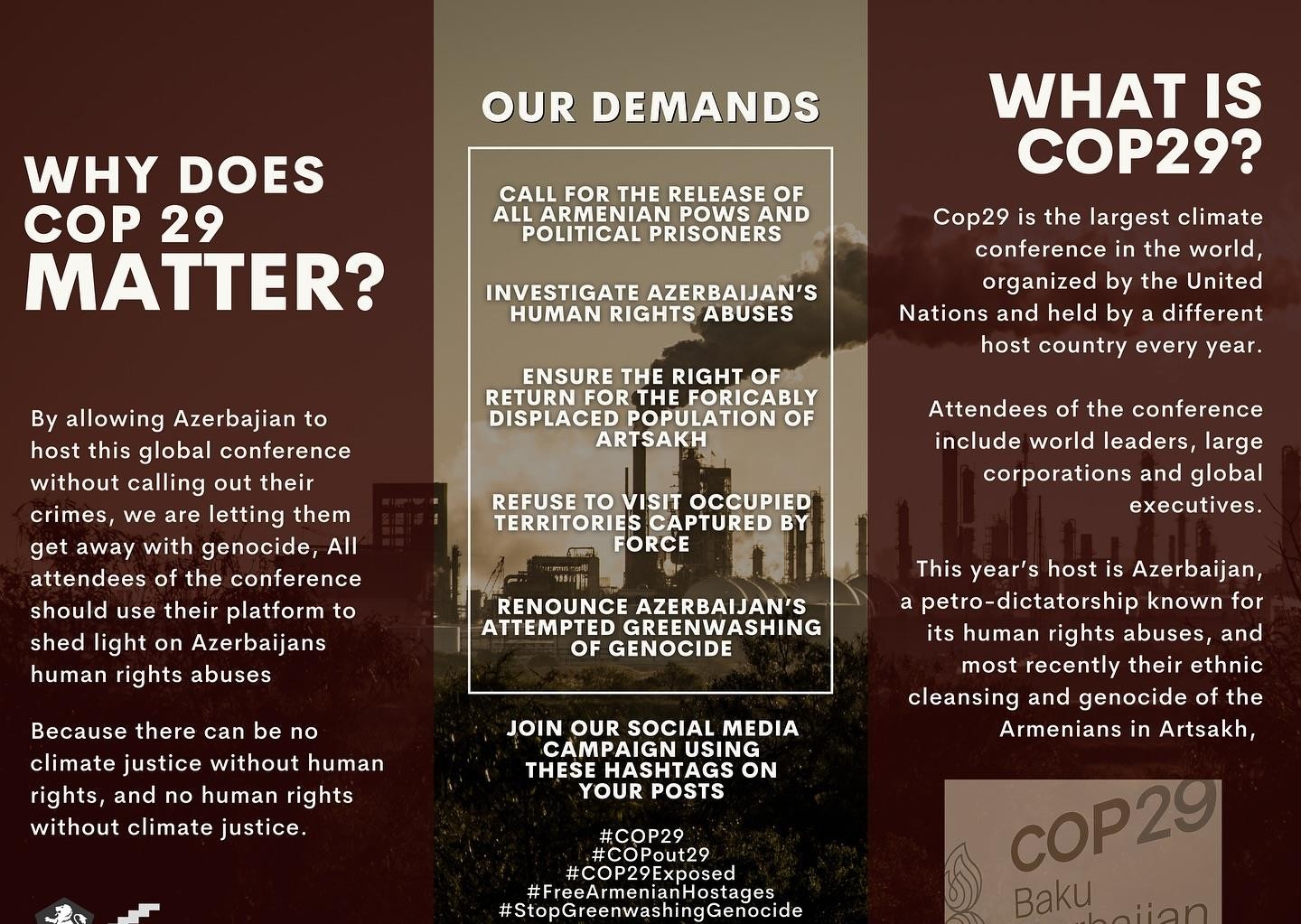
9.
Mention key outcomes of COP29?
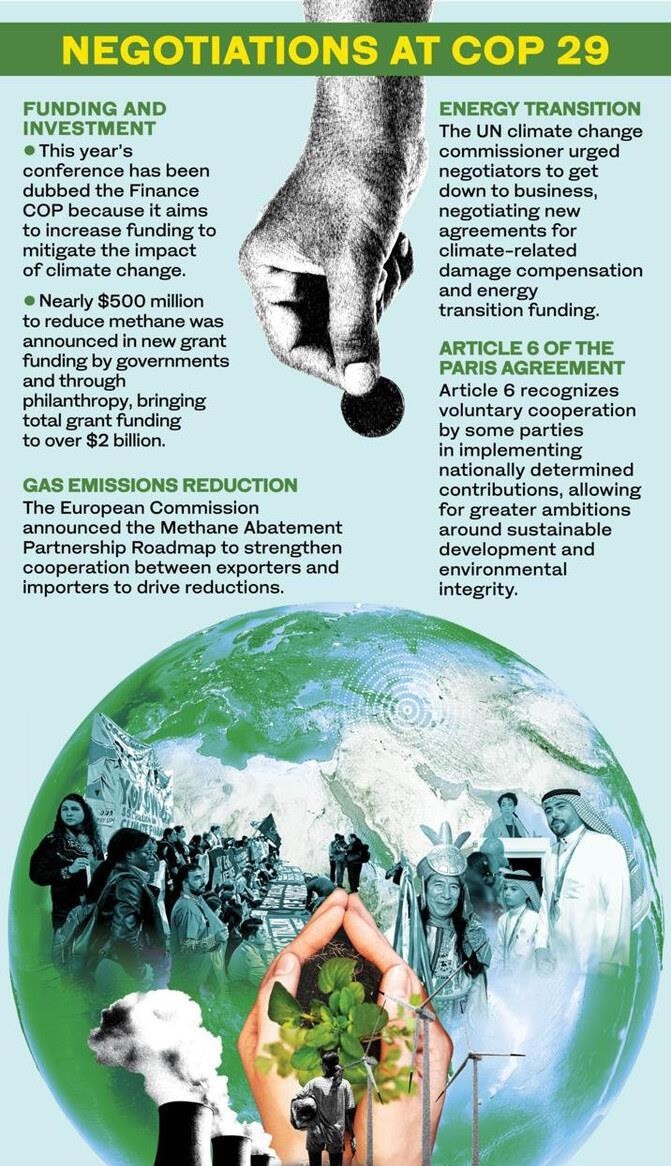
- The recently concluded COP29 in Baku marked another critical milestone in global climate action with mixed outcomes.
- Developed nations committed to channeling at least $300 billion annually into developing countries by 2035 for climate action.
- However, this fell short of the $1.3 trillion annual target demanded by developing nations.
| Outcome | Analysis |
|---|---|
| New global climate finance goal |

|
| Mitigation work programme |

|
| Global goal on adaptation |

|
| Article 6.4 |
|
| Indigenous peoples platform |

|
| Loss and Damage Fund |

|
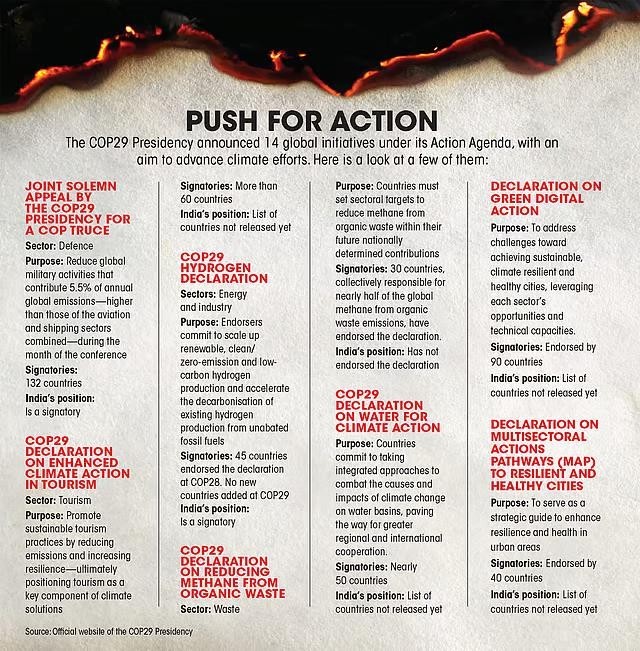
10.
What is article 6?
- Article 6.4 of the Paris Agreement is a UN-led carbon crediting mechanism that allows countries to trade carbon credits.
- It's also known as the Paris Agreement Crediting Mechanism (PACM).
- Under the text agreed on Article 6.4, there is a clear mandate for the UN carbon market to align with science.

11.
What are the challenges faced by COP29?

| Challenges | Analysis |
|---|---|
| National Adaptation Plans (NAPs) |

|
| New Collective Quantified Goal (NCQG) |


|
| Global Stocktake Outcomes (GST) and Fossil fuel transition |

|
| Mitigation Work Programme (MWP) |

|
| Unilateral Trade Measures |

 |
12.
How much influence does the COP Presidency have on issues addressed at negotiations?
- There are often a lot of questions about the role of the COP Presidency, and it is not easy to explain to people why climate change negotiations are happening in big oil-producing countries.
- The role of the COP Presidency is to moderate the negotiations.
- They have a strong role in trying to facilitate agreement on very thorny issues.
- It's a hugely important diplomatic exercise to try and sort out possible disagreements, ideally ahead of time.
- It is a key role, but it is not so influential that the COP Presidency can sway the whole negotiations.
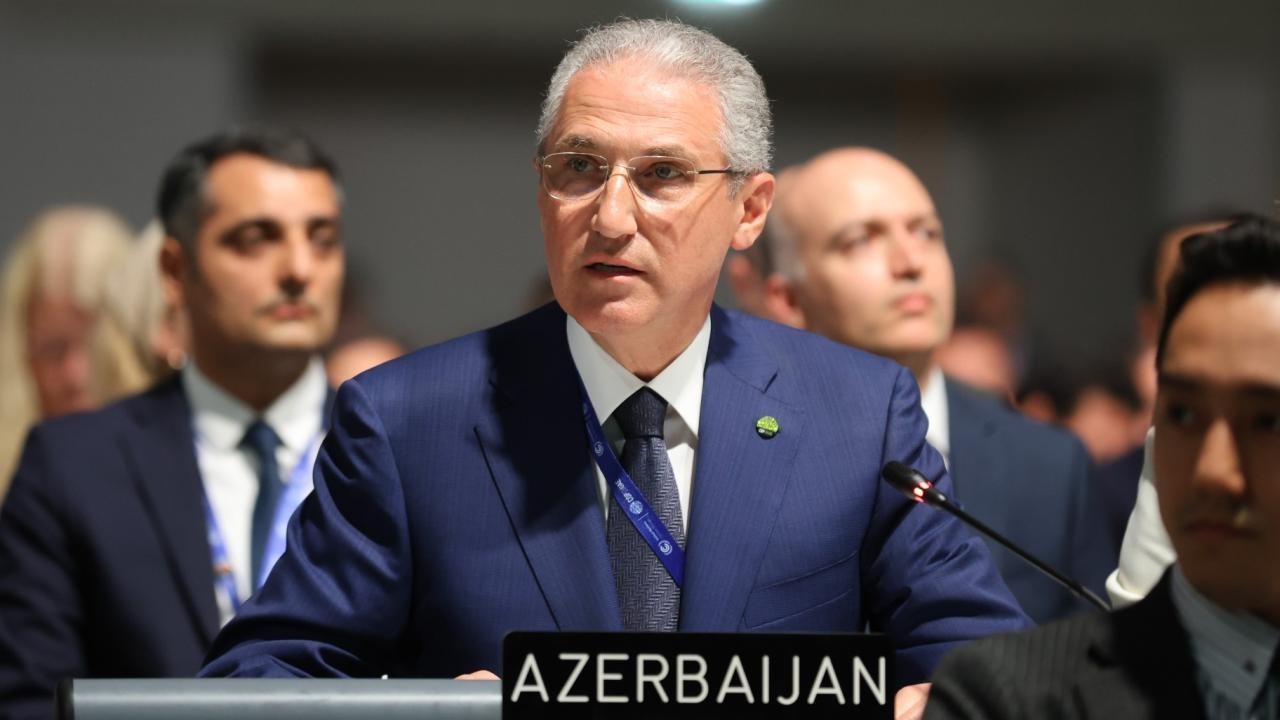
13.
How does the U.S. view climate agreements?
- Until 2006, the U.S. was the world‟s largest emitter of greenhouse gases.
- As the world‟s largest economy, its general attitude towards the European Union-backed climate pacts has been to project itself as solving the climate crisis but being non-committal towards taking the legally binding emission cuts that this entailed.
- Right from the first Conference of Parties in Bonn in 1995, the U.S. expressed discomfort with a fundamental axiom of the UNFCCC which is the mother convention that gives treaties such as the Kyoto Protocol and the Paris Agreement meaning.
- This is because carbon dioxide concentrations in the atmosphere were largely due to historical emissions by developed countries.
- It also translated to developing countries continuing on a fossilfuel pathway.
- Due to discomfort expressed by major fossil fuel economies like the U.S., Australia, and Canada — ideas such as joint implementation (where countries earn credits for implementing clean energy projects in developing countries) surfaced.
- The U.S., despite having walked out of climate agreements, continues to send large delegations to the conference as 'observers' and be closely involved in negotiations.
- In 2005, at COP 11 in Montreal, Canada, the head of the U.S. delegation, as reported by The New York Times, walked out of the negotiations despite the U.S. not being part of the Kyoto Protocol at the time.
- The U.S. remains the world‟s largest crude oil producer and achieved record production in 2023.
- The country is also the largest producer of gas and, in 2022, became the world‟s largest exporter of liquefied natural gas.
- Mr. Trump has committed to adding to this already substantial base.
- Despite all this, the U.S. is critically short of achieving its greenhouse gas emissions target.
- As of 2022, the U.S. has achieved only about one-third of its 2030 emissions reduction goal.
- In the last weeks of his presidency, Mr. Biden increased the U.S. emissions reduction commitments to 61%-66% of 2005 levels by 2035.
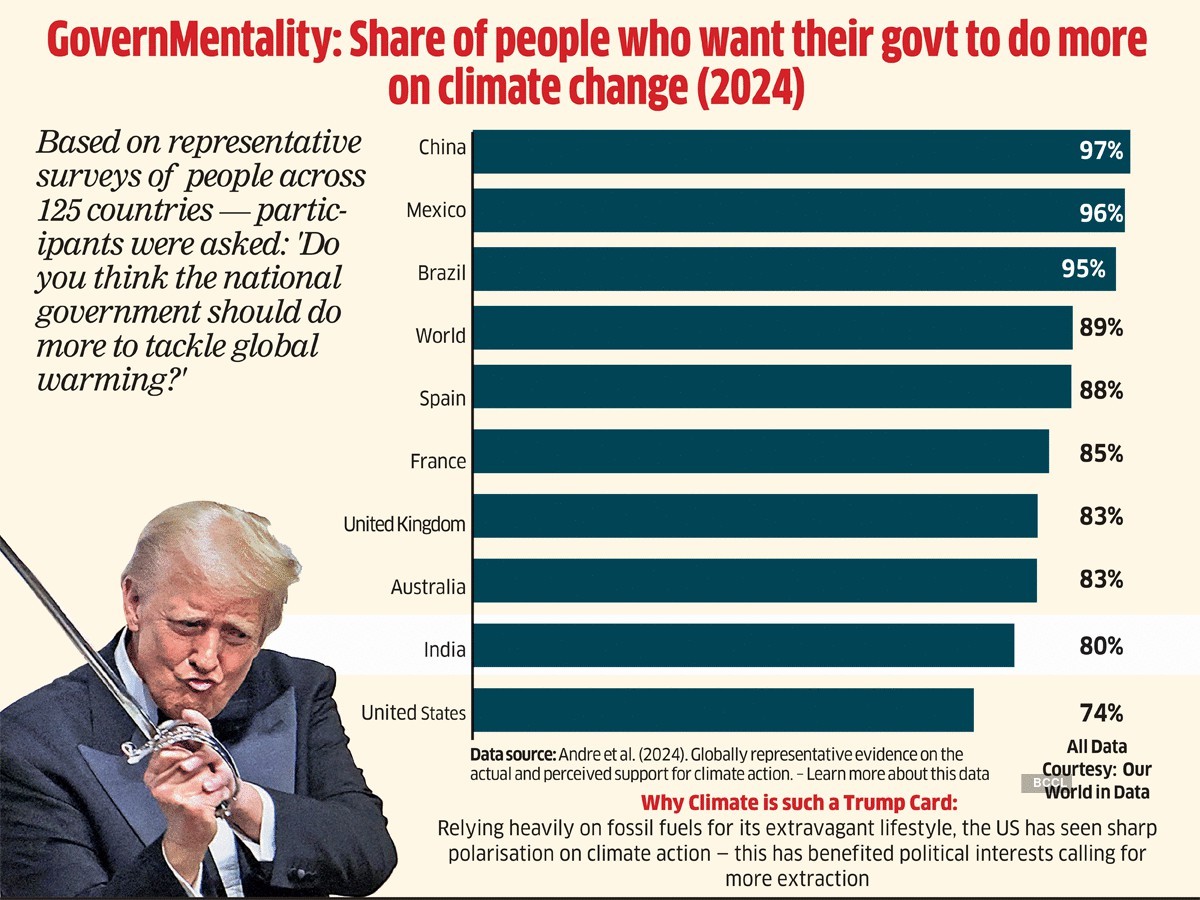

14.
What will be the fallout of the U.S. exit?

- The U.S. has only exited the Paris Agreement, not the overarching UNFCCC.
- Several analysts have pointed out that the scale of investments in renewable energy, including private finance from the U.S., have vastly grown since 2017.
- Unlike India, China, and Indonesia — large developing economies dependent on coal, the U.S. is less reliant on it.
- The U.S. has historically supported the EU on anti-coal positions in climate negotiations.
- Mr. Trump's espousal of a "Drill, baby, drill!" motto encourages more fracking and oil-and-gas drilling, which previous dispensations have only modestly slowed.

- A U.S. exit might lead to developing countries taking on less ambitious targets, but given that climate targets have not managed to slow down global emissions, the U.S.'s exit at this point means little.
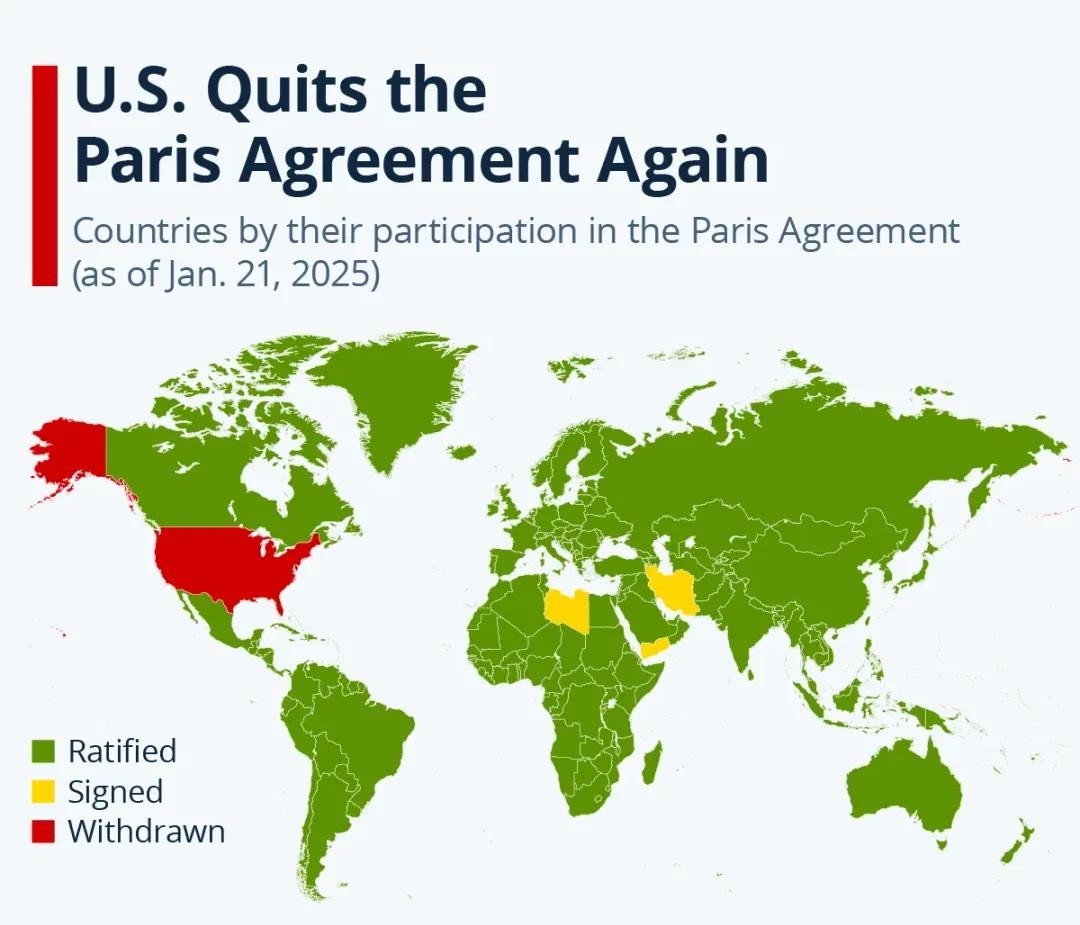
15.
How can COP29 benefit India?
| Benefits | Analysis |
|---|---|
| Benefits of Article 6.4 for India |
 |
| Harmonising the price of carbon credits |
|
| Opportunities for India under NCQG |
|
| Need for south-south cooperation |
|
| Leveraging the Baku-to-Belem roadmap |
|
16.
Why is India disappointed with COP 29?
- India expressed disappointment at the shifting of focus from enablement of adequate Climate Finance to emphasis only on mitigation, at the Plenary Session at the CoP29 of the UN Climate Change Summit in Baku, Azerbaijan.
- India aligned its stance with the statement made by Bolivia on behalf of Like-Minded Developing Countries (LMDCs) and reiterated that the process of the fight against Climate Change has to be guided by the UNFCCC and its Paris Agreement, as the Global South continues to face the intense impacts of Climate Change.
- India put forth its stance on the following issues that are critical in the fight against Climate Change.
- They are:
| Issues | Analysis |
|---|---|
| New Collective Quantified Goal (NCQG) |
|
| Mitigation |
|
| Just Transition |
|
| Global Stocktake( GST) |
On the GST India stated the following:
|
| Adaptation |
|
17.
Where do we stand on climate change mitigation and future prospects wrt to mitigation in the upcoming COP?
- Looking back at COP 28 in Dubai, the biggest breakthrough in those negotiations was the inclusion of language on fossil fuel transition and expanding renewable energy capacity.
- That was huge because reducing greenhouse gas emissions is really the essence of tackling climate change.
- Whether it happens in the context of discussions on the mitigation work program or in discussions on guidance for the next round of NDCs doesn't really matter.
- What matters is that we get clear signals that countries are committed to transitioning away from fossil fuels, and they will make the next 5 years really count toward keeping 1.5 °C alive.

18.
What next for COP30?
- COP29 saw the Global North abandon its obligations to enable the climate transition in the developing world for the remaining part of this decade when urgent climate action is crucial.
- Up next is the update to the NDC cycle, which will see calls to raise ambition from “all” climate polluters and victims in an audacious act of hypocrisy from the Global North.
- COP30 host Brazil—itself a growing power and diplomatic behemoth—played a part in rushing through the finance issue in Baku, not wanting to deal with the mess of this negotiation in Belem next year.
- Brazil‟s Presidency offers both promise and reason for caution.
- An emerging Global South leader in an increasingly multipolar world that has been vocal about sticky issues like the unsavoury hegemony of the dollar in global trade, and the need to tax the ultrawealthy, Brazil has the opportunity to tilt the scales and reclaim the ground that G77 gave up in bargaining power this year.
- Brazil has raised the issue of operationalising equity in the phaseout of fossil fuels which was missing in the GST outcome of 2023.
- Many argue it is too late to save the climate, but those who have been fighting the fight know it is only too late if we give up.
18.
What should be the way ahead?
- Bold and urgent actions are required to match ambition with reality. To bridge the gap between current climate actions and the 1.5°C target, a multipronged strategy is needed:
| Way ahead | Analysis |
|---|---|
| Everyone has a role to play |
|
| Accelerated Decarbonisation |
|
| Energy Efficiency and Electrification |
|
| Climate Finance |
|
| Nature-Based Solutions |
|
| Stronger International Cooperation |
|
What is the relevance of the topic for UPSC CSE?
For Prelims: United Nations Framework Convention on Climate Change, New Collective Quantified Goal , Carbon markets, United Nations, Nationally Determined Contributions, Global Methane Pledge, Lima Work Programme on Gender, Food and Agriculture Organization, Green Climate Fund, Lifestyle for Environment (LiFE), Mangrove Alliance for Climate.
For Mains: India’s Climate Policy, COP29 and its Outcomes, Global Climate Governance, India’s Leadership in Global Climate Initiatives
Some Previous Years Prelims Questions
Q1. Consider the following activities:
1. Spreading finely ground basalt rock on farmlands extensively
2. Increasing the alkalinity of oceans by adding lime
3. Capturing carbon dioxide released by various industries and pumping it into abandoned subterranean mines in the form of carbonated waters
How many of the above activities are often considered and discussed for carbon capture and sequestration?
(a) Only one
(b) Only two
(c) All three
(d) None
Q.2 Consider the following statements:
Statement-I: Carbon markets are likely to be one of the most widespread tools in the fight against climate change.
Statement-II: Carbon markets transfer resources from the private sector to the State.
Which one of the following is correct in respect of the above statements?
(a) Both Statement-I and Statement-II are correct and Statement-II is the correct explanation for Statement-I
(b) Both Statement-I and Statement-II are correct and Statement-II is not the correct explanation for Statement-I
(c) Statement-I is correct but Statement-II is incorrect
(d) Statement-I is incorrect but Statement- II is correct
Some Previous Years Mains Questions
Q.1 The Intergovernmental Panel on Climate Change (IPCC) has predicted a global sea level rise of about one meter by AD 2100. What would be its impact in India and the other countries in the Indian Ocean region?(2023-15 Marks)
Q.2 Describe the major outcomes of the 26th session of the Conference of the Parties (COP) to the United Nations Framework Convention on Climate Change (UNFCCC). What are the commitments made by India in this conference? (2021-15 Marks)
Some Questions from This Year and Previous Years Interview Transcripts
Board Dinesh Dasa sir:
- What has the Indian PM committed regarding chemicals in COP 21 & COP 26?
Board Preeti Sudan mam:
- What are India's renewed commitments under UNFCCC CoP?
Board Suman Sharma mam:
- What is the Conference of Parties(COP)?
Board Suman Sharma mam:
- The Government of India has taken some steps for climate change, what are those?
Some Questions for QUIZ
Q.1 With reference to the Conference of the Parties (COP), consider the following statements:
1. The first COP meeting was held in Berlin, Germany in March, 1995.
2. The COP aims to promote international cooperation and action to address climate change, including reducing greenhouse gas emissions.
3. It is a permanent body of the United Nations.
How many of the above statements are correct?
(a) Only one
(b) Only two
(c) All three
(d) None
Some Questions for POLL
Q.1 Is India on track with the Paris climate Agreement ?
(a) YES
(b) NO
(c) Can’t say
Q.2 Can India become vishwaguru in mitigating climate change?
(a) YES
(b) NO
(c) Can’t say
QUICK LINKS